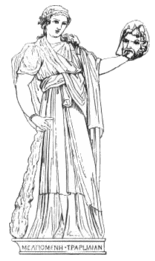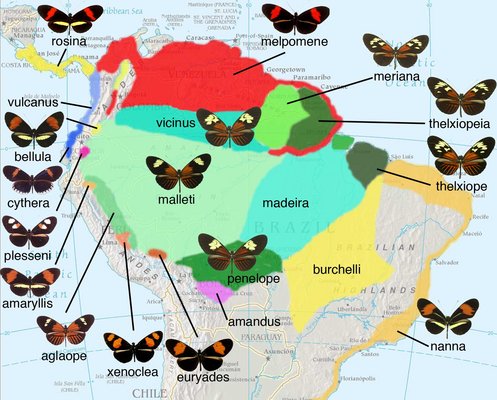Heliconius melpomene
Chris Jiggins, Margarita Beltrán, and Andrew V. Z. BrowerIntroduction
Heliconius melpomene is a widespread neotropical species well known for its geographic diversity in colour pattern. Throughout its range, H. melpomene is co-mimetic with Heliconius erato, and both species have around 30 named geographic sub-species. H. melpomene is generally less abundant than H. erato, but both are found in open areas. H. melpomene can however be locally common in river edges and along streams.
H. melpomene is an ecological host plant specialist in Central America, where it only feeds on either Passiflora oerstedii or Passiflora menispermifolia. In other parts of the range however it is more of a generalist and can be found feeding on several different Passiflora species. Even in Central America, the larvae will happily develop on most species of Passiflora, so the specialisation is due to the oviposition preferences of the females (Smiley, 1978).
The genetic basis of the geographic variation in colour pattern has been extensively worked out over many years of crossing experiments (Sheppard et al., 1985). Just a few genes of major effect control most of the changes. These loci have recently been shown to be shared across several different Heliconius species (Joron et al., 2006).
Etymology: Melpomene is the Muse of tragedy. She is usually represented with a tragic mask and wearing the cothurnus (the boots traditionally worn by tragic actors). Sometimes she holds a knife or a club in one hand, and the mask in the other (Melpomene).
Characteristics
Early stages: Eggs are yellow and approximately 1.5 x 1 mm (h x w). Females usually place eggs singly on stipules and young leaves of the host plant. Mature larvae have a white body with black spots and spines, yellow anal plate and orange head with two black horns; length is around 1.5 cm. Caterpillars are solitary or in small groups of 2-3 individuals. Pupae are brown with gold spots on the dorsum, the thorax is strongly bowed and have five pairs of black spines in the abdomen. The head has short head horns and the antennae have many short black spines (Brown, 1981; DeVries, 1997).
Adult: Heliconius melpomene butterflies are black with a variety of yellow or red bands on forewings and/or hindwings. Forewing length: 35-39 mm.
Geographical Distribution
Heliconius melpomene is widespread throughout Central America and South America.
Geographic distribution of some of the major colour pattern forms of Heliconius melpomene. Names of various geographical races/subspecies are given on the figure. © Chris Jiggins.
Habits
H. melpomene occurs from sea level to 1,400 m in forests edges. Usually individuals fly erratically and in the lower story. Females mate multiply and adults roost in small groups at night at 2-10 m above ground on twigs or tendrils.
Hostplant: H. melpomene larvae feed primarily on plants from the subgenera Granadilla, Plectostemma and Distephana (Brown, 1981). In Costa Rica caterpillars of H. m. rosina feed on Passiflora oerstedii, and P. menispermifolia (Passifloraceae) (DeVries, 1997).
References
Brower AVZ. 1996. Parallel race formation and the evolution of mimicry in Heliconius butterflies: a phylogenetic hypothesis from mitochondrial DNA sequences. Evolution 50: 195-221.
Brown K. S. 1981 The Biology of Heliconius and Related Genera. Annual Review of Entomology 26, 427-456.
DeVries P. J. 1997 The Butterflies of Costa Rica and Their Natural History, Volume I: Papilionidae, Pieridae, Nymphalidae Princeton University Press, Baskerville, USA.
Joron, M, Papa, R, Beltrán, M, Chamberlain, N, Mavárez, J, Baxter, S, Bermingham, E, Humphray, S, Rogers, J, Beasley, H, Barlow, K, ffrench-Constant, R, Mallet, J, McMillan, WO, Jiggins, CD A Conserved supergene locus controls colour pattern diversity in Heliconius butterflies Plos Biology. Vol. 4, No. 10, e303.
Linnaeus, C. [1707_1778] 1758. Systema naturae per regna tria naturae, secundum classes, ordines, genera, species, cum characteribus, differentiis, synomymis, locis. Editio Decima, reformata. Holmiae, Laurentius Salvius. 1: iv , 823 , [1] pp. ([1 January]) [facsimilar reprint in Mid-Continent Lepidoptera Series 2(23), April 1971]
Sheppard PM, Turner JRG, Brown KS, Benson WW, Singer MC. 1985. Genetics and the evolution of muellerian mimicry in Heliconius butterflies. Philosophical Transactions of the Royal Society of London (B) 308: 433-613
Smiley JT. 1978. Plant chemistry and the evolution of host specificity: new evidence from Heliconius and Passiflora. Science 201: 745-7
"Melpomene." Encyclopedia Mythica from Encyclopedia Mythica Online. http://www.pantheon.org/articles/m/melpomene.html [Accessed May 22, 2008].
Title Illustrations

| Scientific Name | Heliconius melpomene amaryllis |
|---|---|
| Specimen Condition | Dead Specimen |
| View | Dorsal |
| Collection | Gerardo Lamas |
| Image Use |
 This media file is licensed under the Creative Commons Attribution-NonCommercial-ShareAlike License - Version 3.0. This media file is licensed under the Creative Commons Attribution-NonCommercial-ShareAlike License - Version 3.0.
|
| Copyright |
©

|
| Scientific Name | Heliconius melpomene aglaope |
|---|---|
| Specimen Condition | Dead Specimen |
| View | Dorsal |
| Collection | Gerardo Lamas |
| Image Use |
 This media file is licensed under the Creative Commons Attribution-NonCommercial-ShareAlike License - Version 3.0. This media file is licensed under the Creative Commons Attribution-NonCommercial-ShareAlike License - Version 3.0.
|
| Copyright |
©

|
About This Page
Chris Jiggins

University of Cambridge, Cambridge, UK

University of Cambridge, Cambridge, UK

Middle Tennessee State University, Murfreesboro, Tennessee, USA
Correspondence regarding this page should be directed to Chris Jiggins at , Margarita Beltrán at , and Andrew V. Z. Brower at
Page copyright © 2010 Chris Jiggins, , and
 Page: Tree of Life
Heliconius melpomene .
Authored by
Chris Jiggins, Margarita Beltrán, and Andrew V. Z. Brower.
The TEXT of this page is licensed under the
Creative Commons Attribution-NonCommercial-ShareAlike License - Version 3.0. Note that images and other media
featured on this page are each governed by their own license, and they may or may not be available
for reuse. Click on an image or a media link to access the media data window, which provides the
relevant licensing information. For the general terms and conditions of ToL material reuse and
redistribution, please see the Tree of Life Copyright
Policies.
Page: Tree of Life
Heliconius melpomene .
Authored by
Chris Jiggins, Margarita Beltrán, and Andrew V. Z. Brower.
The TEXT of this page is licensed under the
Creative Commons Attribution-NonCommercial-ShareAlike License - Version 3.0. Note that images and other media
featured on this page are each governed by their own license, and they may or may not be available
for reuse. Click on an image or a media link to access the media data window, which provides the
relevant licensing information. For the general terms and conditions of ToL material reuse and
redistribution, please see the Tree of Life Copyright
Policies.
- First online 18 February 2007
- Content changed 04 September 2008
Citing this page:
Jiggins, Chris, Margarita Beltrán, and Andrew V. Z. Brower. 2008. Heliconius melpomene . Version 04 September 2008 (under construction). http://tolweb.org/Heliconius_melpomene/72252/2008.09.04 in The Tree of Life Web Project, http://tolweb.org/








 Go to quick links
Go to quick search
Go to navigation for this section of the ToL site
Go to detailed links for the ToL site
Go to quick links
Go to quick search
Go to navigation for this section of the ToL site
Go to detailed links for the ToL site